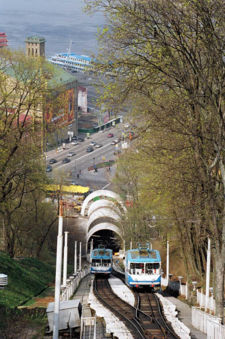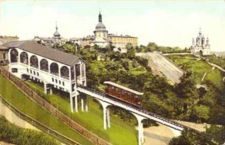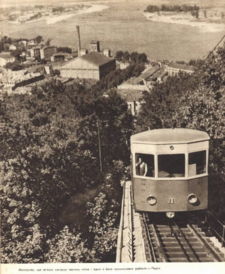Kiev funicular
The Kiev funicular (Ukrainian: Київський фунікулер, translit.: Kyivs’kyi funikuler; Russian: Киевский фуникулёр, translit.: Kievskiy funikulyor) serves the city of Kiev, connecting the historic Uppertown, and the lower commercial neighborhood of Podil through the steep hill overseeing the Dnieper River.
History
The funicular was constructed during 1902-1905, and was first opened to the public on 7 May, 1905. The construction cost, about 230,000 Russian rubles, was covered by a Belgian owner of the Kiev trams. The funicular was the project of Arthur Abrahamson, who received professional training on railroad engineering in Zürich, Switzerland and Saint Petersburg, Russia. The station vestibules were designed by N. Piatnitskiy, and the railway structure was designed N. Barishnikov.
Due to its nearness to the St. Michael's Cathedral, it was once named the Mikhailivs’kyi Mechanichnyi Pidyom (Ukrainian: Михайлівський механічний підйом, literally St. Michael's Mechanical Lift). After the cathedral was destroyed by the Soviet authorities in 1935-1936, the name of the funicular was changed.
Various Facts
The funicular uses a gauntlet track system[citation needed], with two sidings on both sides, so the two cars can pass each other. The two cars of the Kiev funicular have the Cyrillic letters Λ and П which stand for left and right. The funicular was renovated three times: in 1928, 1958, and 1984.
Wheel width: 100 cm. Total track length: 238 meters. The total gradient of the slope on which the funicular runs on is 36 %. The cable cars are powered by an electric motor which is located inside the upper station.
The travel time between the stations is approximately 3 minutes. The route is from the Mykhailivska Square in the Uptown to the Poshtova Square in the Podil. The ticket price is the much like the other city-owned public transportation methods, 50 kopecks. The funicular provides daily service to 10,000-15,000 passengers, and annually to 2.8 million passengers. [1]
The funicular will be closed since September 25, 2006 for restoration, which is usually conducted every year.[2] The total cost of the restoration is expected to be 455,400 hryvnias (about 90,500 US dollars).
Mykhaylo Brodskyy, a Ukrainian politician, claims that when he was young, he participated in the construction of the funicular. [3]
References
- Inline
- ↑ Funicular (Ukrainian). Wiki-Encyclopedia Kyiv. Retrieved on February 26, 2006.
- ↑ Kiev's funicular will be closed for reconstruction (Russian). Gazeta po-Kievsky. Retrieved on September 22, 2006.
- ↑ Chernaya, Olga. Mikhail Brodskiy: «Me in the Kiev Rada - An outsider» in Zerkalo Nedeli, April 8-14, 2006. Available in Russian and Ukrainian
- Kiev's Funicular (Russian). Interesting Kiev. Retrieved on September 17, 2006.
External links
- home.ru - Kiev funicular
- Київський фунікулер in Wiki-Encyclopedia Kyiv (Ukrainian)
- kiev.webteka.com - Kiev funicular (Russian)
| Metros: | Kiev • Kharkiv • Dnipropetrovsk • Donetsk • Kryvyi Rih (fast tram) |
|---|---|
| Trams: | Avdiyivka • Berdychiv • Bilhorod-Dnistrovskyi • Chernivtsi • Dniprodzerzhynsk • Dnipropetrovsk • Donetsk • Druzhkivka • Horlivka • Kerch • Kirovohrad • Kharkiv • Konotop • Kostiantynivka • Kiev • Kramatorsk • Luhansk • Lviv • Nizhyn • Makiivka • Mariupol • Molochne • Mykolaiv • Odessa • Poltava • Sevastopol • Simferopol • Slavyanohirsk • Sloviansk • Stakhanov • Vinnytsia • Yenakiieve • Yevpatoria • Zaporizhia • Zhytomyr |
| Misc: | Kiev funicular • Kiev monorail • Odessa funicular |



